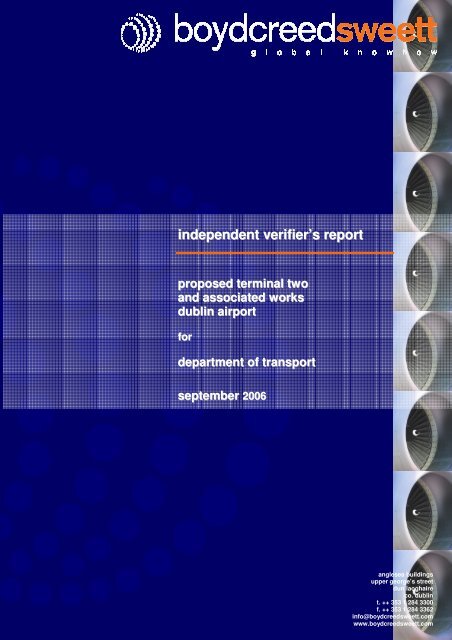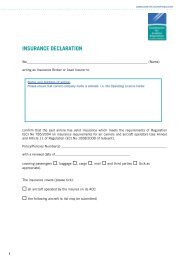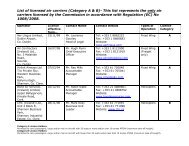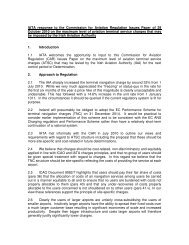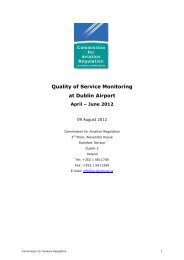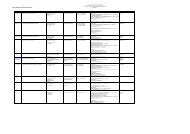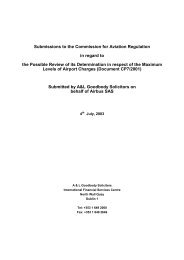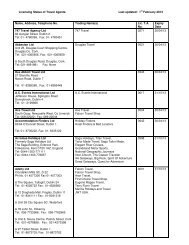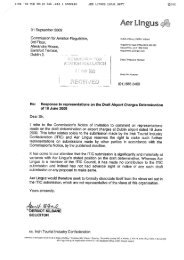independent verifier's report proposed terminal two and associated ...
independent verifier's report proposed terminal two and associated ...
independent verifier's report proposed terminal two and associated ...
- No tags were found...
Create successful ePaper yourself
Turn your PDF publications into a flip-book with our unique Google optimized e-Paper software.
Dublin Airport Terminal TwoIndependent VerifierContentsGlossary of terms 11.0 Executive summary 22.0 Scope of work 52.1 Verification team 52.2 Dublin Airport Terminal Two <strong>and</strong> <strong>associated</strong> works 53.0 Process adopted by DAA <strong>and</strong> its consultants 53.1 Gateway process 64.0 Process adopted by verification team 64.1 Timescale 64.2 Verification team methodology 65.0 Objectives 75.1 Principle DAA objectives for the scheme 76.0 Brief (Gateway) development 86.1 Brief development 86.2 Terminal sizing 96.3 Stakeholder consultation 106.4 Infrastructure 106.5 Passenger h<strong>and</strong>ling 116.6 Baggage holding 116.7 Retail strategy 126.8 Security strategy 126.9 Servicing strategy for building operation 136.10 L<strong>and</strong>scaping 13PROJECTS\1240\Ministerial Report Final 25 th September 2006
Dublin Airport Terminal TwoIndependent Verifier7.0 Design development / option selection (gateway 2) 147.1 Process of option selection <strong>and</strong> evaluation 148.0 Design detail 149.0 Services 1610.0 Transportation 1611.0 Sustainability 1612.0 Flexibility 1613.0 Capital costs 1713.1 Key objectives <strong>and</strong> processes 1713.2 The cost plan methodology adopted 1713.3 The detailed cost plan 1913.4 Building elements 2013.5 Specialist equipment services 2013.6 Enabling <strong>and</strong> external works 2013.7 Inclusions / exclusions 2113.8 Construction <strong>and</strong> project contingencies 2113.9 Costs 2113.10 Conclusion 21Appendix A – Scope of WorksPROJECTS\1240\Ministetrial Report Final 25 th September 2006
Dublin Airport Terminal TwoIndependent VerifierGlossary of termsDAA Dublin Airport AuthorityIATA International Air Transport AssociationICAO International Civil Aviation OrganisationCBPCustoms <strong>and</strong> Border ProtectionPROJECTS\1240\Ministetrial Report Final 125 th September 2006
Dublin Airport Terminal TwoIndependent VerifierConclusionThe Gateway 3 estimated cost of Terminal Two on a cost per square metrebasis, lies at the mid point range of the UK <strong>terminal</strong> buildings benchmarkingstudy carried out by the DAA’s team of consultants. The verification team has<strong>independent</strong>ly verified the benchmarking exercise <strong>and</strong> the cost plan <strong>and</strong>concludes that the estimated cost is within industry norms for this type of projectin a European capital city.Shane BoydDirectorBoyd Creed SweettPROJECTS\1240\Ministetrial Report Final 425 th September 2006
Dublin Airport Terminal TwoIndependent Verifier2.0 Scope of work2.1 Verification team2.1.1 The verification team was appointed by the Department of Transport in March2006 to verify the specification <strong>and</strong> cost of Terminal Two2.1.2 The scope of work for the verification team was set out by the Department ofTransport in their briefing document for the appointment of <strong>independent</strong>verification services for Terminal Two. It outlined the scope of work in relation tothe <strong>report</strong> output as follows:2.1.2.1 process: DAA has appointed its design <strong>and</strong> cost consultants for <strong>terminal</strong> <strong>two</strong>.Accordingly the <strong>independent</strong> experts to be appointed on behalf of the Minister forTransport should have full access to information prior to finalisation of thespecification <strong>and</strong> cost of Terminal Two (including any clarification required fromDAA management <strong>and</strong> their design <strong>and</strong> cost consultants or through attendanceas an observer at meetings with users) to facilitate the timely production of averification <strong>report</strong> following DAA approval of the cost plan.2.1.2.2 output: The experts will provide their opinion in a brief <strong>report</strong> to the Minister forTransport (which ideally should not exceed 10 pages in length) on the following:The methodology <strong>and</strong> approach adopted in the production of the <strong>terminal</strong>design <strong>and</strong> cost plan <strong>and</strong> whether such approach was in line with bestpractice; <strong>and</strong>;In particular, the reasonableness of the overall estimated cost of TerminalTwo arrived at through the above process2.1.3 timescale: The experts would be expected to start work around mid February2006 <strong>and</strong> to submit their <strong>report</strong> to the Minister in mid 2006 upon finalisation byDAA (<strong>and</strong> its consultants) of the design specifications <strong>and</strong> cost plan for TerminalTwo.2.2 Dublin airport Terminal Two <strong>and</strong> <strong>associated</strong> worksAn outline of the scope of work is provided in Appendix A <strong>and</strong> is delineated bythe boundary marked on the plan included in the Appendix. Any works outsidethis boundary are specifically excluded from this <strong>report</strong>.3.0 Process adopted by DAA <strong>and</strong> its consultantsThe key driver for the project timeline is the approval by Government of theAviation Action Plan in May 2005. The action plan provides for the building of aDublin Airport Authority owned new Terminal (Terminal Two) at Dublin Airport tobe open in 2009.PROJECTS\1240\Ministetrial Report Final 525 th September 2006
Dublin Airport Terminal TwoIndependent Verifier3.1 Gateway process3.1.1 In terms of design <strong>and</strong> planning, the DAA <strong>and</strong> its consultants have elected to usea gateway process; akin to the gateway process advocated by the Office ofGovernment Commerce (OGC) in the UK (an <strong>independent</strong> office to the treasurythat works with public sector organisations to gain best possible value for moneyfrom procurement). One of the principal advantages of the gateway process isthat project reviews are carried out by a team of experienced people,<strong>independent</strong> of the programme/project team. This multi-stage process is used toexamine a programme or project at critical stages in its life-cycle to provideassurance that it can progress successfully to the next stage. It is consideredbest practice with this process to achieve ‘sign off’, approval or commitment toeach gateway stage at board level <strong>and</strong> key stakeholders. In addition, the projectdirectors or leaders of the project team should also provide ‘sign-off’.The phases of the gateway process adopted by the DAA <strong>and</strong> its consultants aregiven as:Gateway 1: Brief development/confirmationGateway 2: Design development/option selection stageGateway 3: Architectural treatment/planning submission stage4.0 Process adopted by verification teamThis section provides a high level overview of the process adopted by theverification team <strong>and</strong> the reason for their selection of this approach:4.1 TimescaleThe format <strong>and</strong> timing of the verification process was based on aligning theverification team’s work, whilst carrying out their verification duties, with thegateway process adopted by the DAA. This approach ensured that theverification team’s work did not interfere with the programme or process adoptedby the DAA.4.2 Verification team methodology4.2.1 It was agreed at the outset of the verification team appointment that data wouldbe transferred through single points of contact at the DAA <strong>and</strong> its consultants<strong>and</strong> verification team. A secure web site was utilised to transfer data <strong>and</strong>information between the teams due to the sensitive nature of the information.4.2.2 In addition, the DAA, its consultants, <strong>and</strong> the verification team agreed at theoutset that continuous involvement of the verification team in the process, withregular meetings <strong>and</strong> progress updates would best facilitate the verificationprocess <strong>and</strong> transfer of information. An ‘open’ meeting format was advocated byboth the DAA <strong>and</strong> the verification team so that all issues pertaining to theprocess could be raised <strong>and</strong> discussed amongst the team members.It is considered that this approach provided both parties with an increasedunderst<strong>and</strong>ing of the objectives <strong>and</strong> the range of options available.PROJECTS\1240\Ministetrial Report Final 625 th September 2006
Dublin Airport Terminal TwoIndependent Verifier5.0 Objectives5.1 Principal DAA objectives for the schemeThe brief objectives were established by the DAA <strong>and</strong> its consultants at theoutset of the project; as detailed in the updated briefing document issued at theend of March 2006. This document states that the project objectives weredeveloped in “workshops” in the first week of January 2006; i.e. immediatelyfollowing the appointment of the project manager (ARUP), <strong>and</strong> were reviewed bythe DAA Board on 10th January 2006. The list of objectives detailed in thebriefing document is as follows:5.1.1 High Level ObjectivesDevelopment of a new Terminal, Pier <strong>and</strong> Frontage Road system to cater for10-15 million passengers per annum, but with a view to enabling theprovision of the maximum capacity of the site in due course.The delivery of sufficient capacity in 2009 to meet (as a minimum) thedem<strong>and</strong>s at that time.To deliver the project through a process that is highly visible, auditable <strong>and</strong>efficient, that ensures best value <strong>and</strong> that engages stakeholdersappropriately.Will be delivered at the ‘right cost’ in terms of both capital <strong>and</strong> life cycle.Will be delivered safely <strong>and</strong> in a manner that maintains capacity duringconstruction.5.1.2 With respect to the <strong>terminal</strong>, a number of specific objectives were agreed:Its size should not only meet the required dem<strong>and</strong>, but also remain flexible tochange <strong>and</strong> incorporate US pre-clearance needs.It should meet the needs of the anchor tenant – Aer Lingus – but alsoaccommodate other airlines to ensure optimal utilisation; providing enhancedefficiency for both airlines <strong>and</strong> operator.It should deliver a significant improvement to the customer/passengerexperience.It will include a highly successful retail component.It will deliver high quality, efficient frontline operation accommodation.It will utilise appropriate technology, while remaining flexible to ensure ‘futureproofing’.It will be capable of operating <strong>independent</strong>ly, though systems will bedesigned as <strong>independent</strong> only where this makes good sense.It will be a sustainable, l<strong>and</strong>mark building.PROJECTS\1240\Ministetrial Report Final 725 th September 2006
Dublin Airport Terminal TwoIndependent Verifier5.1.3 The following objectives were agreed for the new pier <strong>associated</strong> with <strong>terminal</strong><strong>two</strong>:It will be the appropriate size.It will be an efficient <strong>and</strong> elegant building.It will yield prime ramp/stores accommodation.5.1.4 Finally, the objectives for the frontages were outlined as:Provide appropriate capacity; reflecting the site environment <strong>and</strong>configuration.Reflect the operational preferences of the Airport.Provide an improved operation for both Terminals 1 <strong>and</strong> 2.6.0 Brief (Gateway) development6.1 Brief development6.1.1 The project takes as its starting point the master plan work previouslyundertaken <strong>and</strong> approved by the DAA. A fundamental premise of this work isthat the new <strong>terminal</strong> will accommodate one anchor tenant with others selectedto maximise utilisation of the facility.6.1.2 The initial estimate for the <strong>terminal</strong> size, arising from the master plan, indicatedthat a <strong>terminal</strong> size of approximately 50,000 square metres would be required toaccommodate a capacity of circa 10 million passengers per annum.6.1.3 Immediately following appointment, the DAA’s consultants were tasked todevelop a robust determination of the size of the facility taking account of thecurrent <strong>and</strong> projected user needs, passenger flow <strong>and</strong> appropriate passengerservice levels. A detailed account of the verification of this process is included inSection 6.2 of this <strong>report</strong>.6.1.4 It is considered that the process adopted for brief development is welldocumented; with high-level objectives having been reviewed <strong>and</strong> approved byDAA Board. Moreover, the project team has sought to establish clear projectplanning parameters working through to detailed operational <strong>and</strong> commercialrequirements in consultation with stakeholders.6.1.5 The defining document ‘Dublin Airport Authority Terminal Two, Initial Brief Report(ref T2.SW.PM.001)’ formed the main deliverable for Gateway 1 (briefdevelopment / confirmation stage). It sets out a clear basis for the designdevelopment of a new <strong>terminal</strong> buildings, pier <strong>and</strong> frontage road system to caterfor 10-15 million passengers per annum with the flexibility to facilitate maximumcapacity of the site.6.1.6 The generic brief development process of advancing the design from briefdevelopment to planning submission stage, as advocated by the Royal Instituteof British Architects, was initiated for this project. This process is also supportedby IATA (International Air Transport Association).PROJECTS\1240\Ministetrial Report Final 825 th September 2006
Dublin Airport Terminal TwoIndependent VerifierThe project sits within the framework of a strategic masterplan. The masterplanapproach is advocated by ICAO (International Civil Aviation Organisation) <strong>and</strong> isconsidered to accord with best practice.6.2 Terminal sizing6.2.1 The high level assessment of sizing for the <strong>terminal</strong> <strong>and</strong> key relationshipsbetween functional <strong>and</strong> operational elements was critical to the initial brief <strong>and</strong>design process. Through development of the brief <strong>and</strong> design, the size of thefacility has been optimised, by refinement of planning data <strong>and</strong> development ofuser <strong>and</strong> stakeholder requirements.6.2.2 In line with best practice, the process of <strong>terminal</strong> sizing was founded on ananalysis of traffic predictions, with a translation of the forecasts into detailedplanning schedules. To this end, a number of airline scenarios that couldpotentially yield an annual passenger dem<strong>and</strong> of between 10-15 millionpassengers per annum, with off-peak operating efficiencies, were appraised bythe DAA <strong>and</strong> its consultants. An underst<strong>and</strong>ing of planning or peak hourdem<strong>and</strong> flows was reached from the resultant schedules, <strong>and</strong> these shaped therequirements for the efficient processing size of facility.6.2.3 In order to determine the appropriate size of the facility, a generic computergenerated “sizing model” was utilised. The model produced a range of peakdem<strong>and</strong> curves based on <strong>two</strong> projected growth rates (of passenger dem<strong>and</strong>) of5% <strong>and</strong> 10% per annum <strong>and</strong> a mid-range level of service st<strong>and</strong>ard. Theresultant graphs provided the basis for the initial <strong>terminal</strong> size. It also providedinformation relating to any future required expansion of the facility to safe guardagainst future growth predictions. The graphs were then adjusted to takeaccount of known passenger movement relating specifically to Dublin airport.6.2.4 The overall results indicated that the project for the <strong>terminal</strong> will best be securedby a <strong>two</strong> phase process.Phase one to incorporate a peak hour passenger through put of 4,200people per hour: this translates to a <strong>terminal</strong> size of circa 74,000m 2 <strong>and</strong> apier size of circa 24,000m 2 .Phase <strong>two</strong> to accommodate an increase in peak hour passenger throughputto 5,500 per hour: this translates to an additional expansion space to the<strong>terminal</strong> of circa 13,000m 2 .This brings added value to the project <strong>and</strong> is considered to be consistent withbest practice.6.2.5 This approach to sizing of the <strong>terminal</strong> <strong>and</strong> key systems follows very closely theguidance within the IATA (International Air Transport Association) AirportDevelopment Reference Manual. The approach is supported by the interrogationof key operational elements of the <strong>terminal</strong> against agreed criteria <strong>and</strong>benchmarks. Moreover, the project team has developed <strong>and</strong> refined themethodology to underst<strong>and</strong> the likely impact of passenger growth <strong>and</strong> therelationship between dem<strong>and</strong> <strong>and</strong> the need for future capital investment.PROJECTS\1240\Ministetrial Report Final 925 th September 2006
Dublin Airport Terminal TwoIndependent Verifier6.3 Stakeholder consultation6.3.1 The involvement of key players <strong>and</strong> the management of stakeholder input wasconsidered by the DAA as integral to the briefing process <strong>and</strong> was thereforeinitiated immediately following the appointment of the DAA’s consultants inJanuary 2006. The process included workshops for stakeholders to enable themto underst<strong>and</strong> the scope of the project <strong>and</strong> included procedures for ‘sign-off’.6.3.2 The number of stakeholders <strong>and</strong> nature of users consulted through the initialstages of the process comprises the majority of main stakeholders including, theanchor tenant, other relevant operational airlines, main external bodies <strong>and</strong>authorities such as Fingal County Council, the Department of Transport <strong>and</strong> theRailway Procurement Agency.6.3.3 Stakeholders have been afforded a range of opportunities by the DAA to provideinput into the project <strong>and</strong> consult with the DAA’s consultants. Indeed, the DAAhas sought to address any stakeholder concerns through the followingmeasures:-Increased advanced notice of upcoming consultation meetingsOne-to-one briefings at the request of stakeholdersAirline “workshops” based around airline consultation meetings6.3.4 The approach follows the guidance within the IATA Airport DevelopmentReference Manual for appropriate consultation between airport planners <strong>and</strong>stakeholders in the development of requirements for a passenger <strong>terminal</strong>facility, <strong>and</strong> therefore accords with best practice.6.4 Infrastructure6.4.1 The impact of the new Terminal Two facility on existing infrastructure wasrecognised in the Initial Brief at Gateway 1 (brief development / confirmationstage). A clear strategy was set out for identifying existing infrastructure <strong>and</strong>establishing dem<strong>and</strong> for new infrastructure as a consequence of the new facility.6.4.2 It was also recognised that the existing services beneath the Terminal Twofootprint will be diverted in an enabling works contract ahead of the mainTerminal Two contract <strong>and</strong> that this work will have to be carefully planned tomaintain operation of the existing facilities. This enabling works contract will alsoneed to incorporate the diversion of existing roads, provision of new serviceroutes <strong>and</strong> a new electrical substation.6.4.3 Bases of design for new infrastructure were established <strong>and</strong> dem<strong>and</strong> calculatedfrom the size of the new <strong>terminal</strong> facilities. Information was collated relating toexisting infrastructure <strong>and</strong> a series of site surveys were set in motion to obtain asmuch definitive information as possible.6.4.4 A strategy was established for the location of new airside services in relation toPier E <strong>and</strong> the airside service road around the pier.PROJECTS\1240\Ministetrial Report Final 1025 th September 2006
Dublin Airport Terminal TwoIndependent Verifier6.4.5 It is concluded that the scope, planning <strong>and</strong> programming of the enabling workscontract are clearly critical to ensuring a timely start to the main Terminal Twocontract <strong>and</strong> maintaining operation of the existing facilities. The methodologyadopted by the DAA Team accords with best practice.6.5 Passenger h<strong>and</strong>ling6.5.1 In the context of the DAA’s high level objectives stated in section 5.1.1, a keydriver for the development of the brief is the requirement for the <strong>terminal</strong> systemto cater for 10 –15 million passengers per annum, whilst offering significantimprovements to passenger experience <strong>and</strong> comfort.6.5.2 The development of the programme of requirements for a new <strong>terminal</strong> would,typically, be based on a range of 75-85% of the peak hour rate of passengerthroughput. Dublin airport experiences a non-typical high peak hour rate <strong>and</strong>consequently, the programme of requirements for the new <strong>terminal</strong> has beenbased on 95% of the peak hour rate. This is considered a reasonable basis inthis instance. The area provision per passenger compares well with otherinternational airports but to meet the dem<strong>and</strong>s of the strong morning departurespeak, staffing levels will have to be maintained during this period. As with allairports, there will be some under utilisation of facilities off-peak. However, theDAA team has worked with the flight schedules as much as possible to smooththe flows <strong>and</strong> minimise this effect.6.5.3 The verification team considers that the DAA <strong>and</strong> its consultants’ methodology,approach <strong>and</strong> execution of the planning objectives <strong>and</strong> considerations forpassengers accords with the best practice.6.6 Baggage h<strong>and</strong>ling6.6.1 The gateway one (brief development / confirmation stage) <strong>report</strong> sets out theprimary objectives for the Terminal Two Baggage H<strong>and</strong>ling System. It notes thatthe system should be designed for the anchor tenant with the facility to serviceadditional airlines to maximise the use of the system. It also states that thesystem is to be robust, cost effective, as well as resilient.6.6.2 It is good practice in the sizing of <strong>terminal</strong> systems <strong>and</strong> sub-systems to smoothout the dem<strong>and</strong>. A balanced baggage h<strong>and</strong>ling system requires expertise inrespect of analysis <strong>and</strong> interpretation of the flight schedules, the development ofthe user requirements <strong>and</strong> to investigate alternative solutions/ technology. Theverification team underst<strong>and</strong>s that this work is being led, on behalf of the DAA,by an international expert (who is a contributor to the technical guidance in theIATA Airport Development Reference Manual), <strong>and</strong> this work follows the IATAmethodology closely.6.6.3 The verification team considers that the process for the analysis <strong>and</strong> simulationof the peak dem<strong>and</strong> for passengers <strong>and</strong> bags from check-in, departures, <strong>and</strong>arrivals flows is in line with best practice.PROJECTS\1240\Ministetrial Report Final 1125 th September 2006
Dublin Airport Terminal TwoIndependent Verifier6.6.4 The DAA <strong>and</strong> its consultants are aware that EU directives with regard tobaggage h<strong>and</strong>ling are currently being revised <strong>and</strong> have recommended that thebusiness <strong>and</strong> planning case should allow for the new requirements <strong>and</strong><strong>associated</strong> technologies. The DAA <strong>and</strong> its consultants will continue to determineany effect of updated directives.6.6.5 The approach adopted follows best practice for IATA st<strong>and</strong>ards for baggageh<strong>and</strong>ling.6.7 Retail strategy6.7.1. One of the principal commercial objectives of the project is to maximisecommercial revenues to the airport through providing an appropriate area forcommercial/ retail opportunities in the key passenger flow areas.6.7.2 To this end, the planning objective is to create a departures lounge surroundedby retail, food <strong>and</strong> beverage outlets <strong>and</strong> linked, if possible, to the existingTerminal 1 retail areas. The verification team notes that a number of airportoperators, including BAA, have successfully adopted this retail model. Also, theIATA guidance supports this approach with the proviso that passengerprocessing operations are not compromised by retail activities.6.7.3 Strategic decisions have been made in respect of the location <strong>and</strong> overall areaprovision for concessions in the region of 8,500 m 2 for the <strong>terminal</strong> <strong>and</strong> pier atapproximately 11% of the <strong>terminal</strong> area. In addition there is 300m 2 retail areawithin the pier. The total provision is within IATA parameters <strong>and</strong> benchmarkinghas indicated that it compares well with other international airports.6.7.4 There is still further market research <strong>and</strong> work in detail needed to determine thesplit between retail, food <strong>and</strong> beverage <strong>and</strong> servicing requirements. Sign-off ofthe final departures lounge layout with all major stakeholders will be important toensure buy-in <strong>and</strong> operational <strong>and</strong> security protocols.6.7.5 To conclude this section, the verification team notes that the approach adoptedfollows best practice as recommended by IATA.6.8 Security strategy6.8.1 The initial DAA project brief states that design objectives in respect of securityfor the new <strong>terminal</strong> are to comply with national, EU <strong>and</strong> international legislation<strong>and</strong> makes particular reference to the requirements of the Department ofTransport. These objectives are generally in line with international guidance <strong>and</strong>the strategy is programmed for further development during the detailed designstage.6.8.2 The DAA <strong>and</strong> its consultants have consulted with the DAA’s own securitysection, the Department of Transport <strong>and</strong> an IATA security specialist in thecourse of the Gateway process. The outcomes of the consultation process havebeen incorporated into the planning application designs for the project.PROJECTS\1240\Ministetrial Report Final 1225 th September 2006
Dublin Airport Terminal TwoIndependent Verifier6.8.3 Terminal Two will offer full segregation between departing <strong>and</strong> arrivingpassengers. Terminal 1 is not segregated <strong>and</strong> there will be some airsideconnectivity issues to be resolved at the detailed design stage.6.8.4 In conclusion, the verification team affirms that the consultation process onsecurity strategy adopted by the DAA <strong>and</strong> its consultants accords with bestpractice.6.9 Servicing strategy for building operation6.9.1 The servicing strategy has been developed with adequate reference to securityconsiderations. There has been careful attention given to control of passengermovement, bags, staff, goods <strong>and</strong> waste products across the airside l<strong>and</strong>sideboundary. In addition, innovative ideas in respect of air locks, access formaintenance <strong>and</strong> management of deliveries in a restricted environment areapparent in design development.6.9.2 A detailed development of a trolley management strategy that includes theretrieval of trolleys from car parks for timely delivery to check-in <strong>and</strong> reclaim hallsto service the peak hour dem<strong>and</strong> necessary during the design developmentstage.6.9.3 A high level review for the maintenance <strong>and</strong> cleaning requirements of thebuilding has been incorporated into the current plans. This will be furtherdeveloped during the course of the design development stage.6.9.4 Large mechanical <strong>and</strong> electrical (M&E) equipment has generally been located onroof tops, at the perimeter of the buildings <strong>and</strong> within the central equipment area.This follows general good practice <strong>and</strong> should make both maintenance <strong>and</strong>replacement of major items of equipment easier. In addition to this the use ofservice corridors has been provided for the main routing of the M&E installations.A general servicing strategy will be required for all major items of M&Eequipment as well as any other M&E equipment installed within the buildings.6.9.5 The objectives <strong>and</strong> considerations in respect of servicing <strong>and</strong> maintenancefollow the guidance contained within the IATA st<strong>and</strong>ards. An overall servicingstrategy for maintenance needs will be developed in the design developmentstage.6.10 L<strong>and</strong>scaping6.10.1 Further consideration will be given to the specification of plants <strong>and</strong> waterfeatures in the detail design development of the l<strong>and</strong>scape strategy for TerminalTwo with particular reference to best practice (l<strong>and</strong>scape development guidancecontained in the Civil Aviation Policy CAP 680 – Aerodrome Bird Control).PROJECTS\1240\Ministetrial Report Final 1325 th September 2006
Dublin Airport Terminal TwoIndependent Verifier7.0 Design development /option selection (gateway 2)7.1 Process of option selection <strong>and</strong> evaluation7.1.1 The project team’s key objective for Gateway 2 was the ‘preparation of a rangeof design option concepts for high level evaluation, then selection of a singleconcept for design development in the next stage’. The selected option wouldbe submitted for planning approval.7.1.2 Their approach was to evaluate option ‘families’ to identify the areas where theoptions perform comparatively well or poorly, to identify the risk <strong>and</strong> performanceprofile <strong>and</strong> to capture potential modifications/ improvements to the emergingdesigns to feed into the next stages of design development. Essentially this is acomparative analysis that rates the performance of the Gateway 2 options for arange of attributes.7.1.3 Eight main criteria categories, weighted in accordance with the DAA’s statedhigh level objectives (section 5.1.1) were identified <strong>and</strong> the performance of eachdesign option was evaluated against these categories.7.1.4 Three options were designed <strong>and</strong> evaluated against the objectives <strong>and</strong> criteria atGateway 2. One of these options was selected on the basis of the highestranking performance. Further designs were developed around the selectedoption to enhance overall performance.7.1.5 The option appraisal process adopted by the DAA <strong>and</strong> its consultants accordswith best practice.8.0 Design detail8.1 The new <strong>terminal</strong> is accessed by vehicles via newly configured l<strong>and</strong>side roadsystems. The forecourt interfaces with a remote check-in building, separatedfrom the main Terminal Two building to facilitate realignment of the roadsne<strong>two</strong>rk <strong>and</strong> to provide road access to Terminal 1 between the <strong>two</strong> Terminal Twobuildings. At a strategic level the plan provides for future connections fortransport interchanges <strong>and</strong> future stages of multi-storey car park development.8.2 The layout of the buildings is good. There is a clear axis <strong>and</strong> primary circulationroute from passenger set down in the forecourt through the Terminal Two to thepier. Further definition is given by a line of glazing in the roof bringing in naturallight, guiding passenger flow through the process of check-in, security control<strong>and</strong> into the departures lounge.8.3 Accommodation is arranged on three main levels, baggage make up hall(assembly of baggage for transfer to airplanes) at apron level, arrivals <strong>and</strong>reclaims hall at first floor level <strong>and</strong> departures at second. The departures routestarts at ground floor in the remote check-in facility <strong>and</strong> then rises to second floorlevel to the departures lounge <strong>and</strong> then drops down to the first floor to the pier<strong>and</strong> gates. From aircraft the arrivals route is via jetties to the pier at a mezzaninelevel above departures (first floor) in the pier <strong>and</strong> is at grade with arrivals level inthe <strong>terminal</strong> providing ease of access to the reclaim hall.PROJECTS\1240\Ministetrial Report Final 1425 th September 2006
Dublin Airport Terminal TwoIndependent VerifierThe route then bridges across roads infrastructure to Terminal 1 <strong>and</strong> thepassenger set down to Terminal Two, dropping down to ground level to facilitateexit of the passenger <strong>terminal</strong> site.8.4 Baggage is transferred from check-in to the baggage hall at a mezzanine levelbetween the <strong>terminal</strong> arrivals level <strong>and</strong> apron level. The <strong>terminal</strong> is servicedthrough a service yard to the east of the <strong>terminal</strong>. The facility will provide bothairside <strong>and</strong> l<strong>and</strong>side facilities for goods in <strong>and</strong> waste management with theappropriate level of screening for goods being delivered airside.8.5 The arrangement of <strong>and</strong> relationship between primary functions is generallycorrect i.e. functions located correctly with reference to other dependentfunctions. More detailed work with stakeholders is still required to hone <strong>and</strong>reconcile Programme Requirements (Appendix D of the Initial Brief), in particularareas <strong>and</strong> level of facility provision in future stages of the project.8.6 The architectural form is dynamic <strong>and</strong> appropriate for an aviation <strong>terminal</strong> <strong>and</strong>international gateway building. The project team is still evaluating roofing <strong>and</strong>cladding elements in respect of performance. The generic descriptions formaterials to the external envelope <strong>and</strong> finishes are adequate at this stage foraccompanying the planning application.8.7 The cost plan reflects the adoption of a structural steel frame supportingcomposite in-situ concrete suspended floor, a structural steel truss roof,supported off shallow pad foundations. The verification team suggests that astructural specification is produced as soon as practical <strong>and</strong> cost checkedagainst the cost plan allowance.8.8 This structural scheme is consistent with the Gateway 2 (design development /option selection stage) <strong>report</strong> options <strong>and</strong> has been developed in a logical <strong>and</strong>thorough manner. The scheme is consistent with structural solutions for anumber of similar airport <strong>terminal</strong> buildings.8.9 The foundation proposals have been developed based upon certain assumptions<strong>and</strong> anecdotal evidence relating to ground conditions. The level ofcontamination also appears to have been based upon anecdotal evidence.These assumptions must be reviewed when the ground investigations have beencompleted.8.10 The structural solution will also need to be reviewed <strong>and</strong> developed in detailagainst the performance criteria <strong>and</strong> ‘Building Structure design Criteria’ specifiedin the Initial Brief <strong>and</strong> Gateway 2 (design development / option selection stage)<strong>report</strong>s.8.11 As part of Pier C is designed to be subsumed into the parameters of TerminalTwo, the DAA <strong>and</strong> its consultants are examining its construction to ensurecompatibility with the Terminal Two design.8.12 To conclude this section, it is considered that the development of the structuralproposals is in accordance with best practice, <strong>and</strong> the scheme chosen iscomparable with that used in similar airport <strong>terminal</strong> buildings.PROJECTS\1240\Ministetrial Report Final 1525 th September 2006
Dublin Airport Terminal TwoIndependent Verifier9.0 Services9.1 The M&E design detail of the project reflects the level of detail that would betypically expected at this project stage. All schematics for the installations areindicative but the strategy for same is well documented.9.2 It should be noted that the proposal for building in spare capacity (toaccommodate future requirements), within the mechanical plant may lead to theplant efficiency initially being lower than anticipated.10.0 Transportation10.1 The development of the l<strong>and</strong>side highway <strong>and</strong> kerbside design strategy is theoutcome of a logical <strong>and</strong> well-structured process.10.2 The planning application drawings take account of the transportation issues interms of segregation of arriving <strong>and</strong> departing passengers as well as variousmodes of transport.10.3 The main transportation impacts are considered to be the provision for carparking <strong>and</strong> location of the <strong>proposed</strong> metro link to the airport. The <strong>proposed</strong>metrolink to the airport is outside the scope of this <strong>report</strong>.10.4 The transportation solution provides a clear <strong>and</strong> logical access strategy toTerminal <strong>two</strong> <strong>and</strong> maintains good, segregated, access to Terminal 1.10.5 The verification team suggests that the implications of a temporary closure of theroute between the Terminal Two buildings (see 8.1) should be considered inrelation to maintaining access to Terminal One.11.0 SustainabilityThe DAA’s team has considered numerous renewable energy <strong>and</strong> wastesystems for installation at the site with most of them noted as requiring furtherinvestigation. The provision of any renewable source may have an impact oninitial cost outlays <strong>and</strong> operational costs for the project.12.0 Flexibility12.1. As previously stated in section 6.2, <strong>two</strong> growth rates 5% <strong>and</strong> 10% per annumwere applied to a range of peak dem<strong>and</strong> curves <strong>and</strong> developed through to 2020.The sizing model also provides a useful tool in the underst<strong>and</strong>ing of the risk <strong>and</strong>consequences if the dem<strong>and</strong> differs from expectations. The precise timing <strong>and</strong>scale of the phase <strong>two</strong> will be dependent on how dem<strong>and</strong> actually manifestsitself.12.2 An area to cater for the expansion of facilities in the event of further passengergrowth has been safeguarded to the east of the <strong>terminal</strong> above the <strong>proposed</strong>service yard.PROJECTS\1240\Ministetrial Report Final 1625 th September 2006
Dublin Airport Terminal TwoIndependent Verifier12.3 Expansion capability for CBP facilities has been identified to the west of the<strong>terminal</strong> above the apron level baggage hall.12.4 The road systems for Terminal 1 <strong>and</strong> Terminal Two have been designed to be<strong>independent</strong> of each other <strong>and</strong> this will help traffic circulation. However, theneed to provide flexibility of traffic routes in the event of blockages at keylocations in the road system should be considered as the design is developing.12.5 As previously noted, the infrastructure plan facilitates future nodal connections tothe <strong>proposed</strong> transport interchange <strong>and</strong> future stages of multi-storey car parkdevelopment.12.6 From a structural perspective, the chosen option appears to provide themaximum amount of flexibility for the Phase 2 extension since the facilities willbe capable of expansion on three separate sides.12.7 In addition, the structural form (in-situ composite floors on steel frame) providesthe best compromise for flexibility to incorporate modifications <strong>and</strong> addition ofservice holes during <strong>and</strong> after construction.13.0 Capital costs13.1 Key objectives <strong>and</strong> Process13.1.1 The key highlighted objectives relating to capital cost are stated as:the right cost: capital <strong>and</strong> life cycleoperational efficiencyappropriate technology <strong>and</strong> future proofing13.1.2 The DAA’s briefing document for consultants’ appointments states that “Best‘Practice Approach” is to be implemented including the use of benchmarking /current industry practice.13.1.3 The process for defining the capital costs was outlined in the cost consultant’s<strong>report</strong> of March 2006. It included a process for the production of an Outline CostPlan at Gateway 2 (design development / option selection stage), <strong>and</strong> a DetailedCost Plan at Gateway 3 (architectural treatment / planning submission stage).This process of cost plan development aligned with the gateway processadopted by the DAA.13.2 The cost plan methodology adopted13.2.1 Prior to evaluating any options, benchmark costs on a cost per metre squarebasis for comparable UK airport developments were <strong>independent</strong>ly developed bythe DAA’s cost consultant. The costings were analysed <strong>and</strong> adjusted to ensurethat they were presented on a like-for-like basis.PROJECTS\1240\Ministetrial Report Final 1725 th September 2006
Dublin Airport Terminal TwoIndependent Verifier13.2.2 The resulting benchmarking <strong>report</strong> was presented to the DAA <strong>and</strong> othermembers of the project team in order to provide a benchmark for the outline costplans for the various Gateway 2 (design development / option selection stage)options, <strong>and</strong> to assist in the evaluation thereof.13.2.3 Gateway 2 encompassed a cost review of the following areas:the Terminal Two building<strong>associated</strong> kerb / infrastructure workpier E <strong>and</strong> <strong>associated</strong> apron worksphasing <strong>and</strong> temporary works13.2.4 A series of options were <strong>proposed</strong> <strong>and</strong> these were each evaluated under thefollowing cost headings to enable ranking of the best performing optioncapital costsoperational <strong>and</strong> life cycle costsasset write offretail <strong>and</strong> concessions revenues13.2.5 Capital costs were developed for each of the various options based on:building plans <strong>and</strong> areas schedulessite locationskerbside, roads <strong>and</strong> infrastructurephasing <strong>and</strong> temporary worksindicative plans for works to / interfaces with existing buildings13.2.6 The resultant estimated capital cost was included in the “commercial” segment ofthe option evaluation matrix <strong>and</strong> scored in a range from “performs well” to“performs poorly” against the benchmark of the best performing option.13.2.7 Operational <strong>and</strong> life-cycle costs were assessed under the headings of “payroll”<strong>and</strong> “non payroll”. Items such as security costs, <strong>terminal</strong> management <strong>and</strong>insurances were not included as they were not considered to be materiallydifferent for each option.13.2.8 The resultant estimated operational <strong>and</strong> life cycle costs for each option wereincluded in the “commercial” segment of the option evaluation matrix <strong>and</strong> scoredin a range from “performs well” to “performs poorly” against the benchmark of theoption with the lowest identified cost. This forms the basis of a qualitativeassessment.PROJECTS\1240\Ministetrial Report Final 1825 th September 2006
Dublin Airport Terminal TwoIndependent Verifier13.2.9 A full life cycle cost analysis would be expected to take into consideration theperformance of any given options / materials <strong>and</strong> their possible alternatives interms of:capital costsperiodic maintenance costsrunning costsreplacement costs13.2.10 This analysis is typically undertaken during the design development stage <strong>and</strong>we would expect it to be continually updated, refined <strong>and</strong> evaluated through <strong>and</strong>after Gateway 3 (architectural treatment / planning submission stage).13.2.11 The analysis of “asset write off “deals with the effect of any given option or partof an option on the existing DAA building assets in Dublin Airport particularly PierC. For example, option 6 <strong>proposed</strong> the complete demolition of Pier C <strong>and</strong>therefore the complete asset value of Pier C would have to be written off in thisoption.13.2.12 The estimated asset write off costs were included in the “commercial” segmentof the option evaluation matrix <strong>and</strong> scored in a range from “performs well” to“performs poorly” against the benchmark of zero effect.13.2.13 The DAA has stated that retail <strong>and</strong> concession revenues are one of the maingenerators of income for the DAA, as the current operator of Dublin airport.Therefore, “retail revenues” was assigned an individual category under thecommercial analysis segment of the option appraisal.13.2.14 Each option was assessed on the basis of the area of retail <strong>and</strong> concessionspace contained therein, compared against the brief <strong>and</strong> each other, <strong>and</strong> scoredon the option evaluation matrix against the benchmark of highest area provided.13.3 The detailed cost plan13.3.1 The Gateway 3 (architectural treatment / planning submission stage) cost plan isbased on the scheme submitted by the DAA for planning approval on 31 st August2006 <strong>and</strong> covers the following areas:Enabling works, site logistics & phasing / temporary works (1.50%)Pier C refurbishment works (3.00%)Terminal Two (65.50%)The energy centre (1%)Pier E <strong>and</strong> apron remodelling (23.50%)External works (5.50%)13.3.2 The percentages in brackets indicate the percentage of the total estimatedconstruction cost that each area represents.PROJECTS\1240\Ministetrial Report Final 1925 th September 2006
Dublin Airport Terminal TwoIndependent Verifier13.3.3 The cost plan for the enabling works, site logistics & phasing / temporary works,the Pier C refurbishment, the energy centre <strong>and</strong> the external works (combined11%) are largely based on an estimated cost per metre square of gross internalfloor area or estimated lump sum allowances.13.3.4 Strictly speaking this does not accord with best practice. However, it is notunusual to estimate the costs for these items on this basis at this stage of theproject, on the basis that they represent a small portion of the overall total.13.3.5 The cost plan for Terminal Two <strong>and</strong> Pier E (combined 89%) is based on detailedquantities <strong>and</strong> rates. The cost plan is broken down into sections reflecting the<strong>proposed</strong> works packages for future tendering <strong>and</strong> this should simplify thecomparison of budgets <strong>and</strong> tenders on a package by package basis.13.3.6 The cost plan was examined under the following headings:Building elementsSpecialist equipment servicesEnabling worksExternal worksConstruction contingenciesInclusions / exclusionsProject contingenciesCosts13.4 Building elementsThe cost plan is broken down into logical sub sections of cost headings for thebuilding elements. An examination of the estimated construction cost ratesemployed revealed them to be realistic <strong>and</strong> the DAA’s team has confirmed thatthe rates for major cost centres have been market tested.13.5 Specialist equipment servicesA separate section of the cost plan is devoted to specialist equipment serviceswhich includes such items as check-in <strong>and</strong> baggage h<strong>and</strong>ling systems.13.6 Enabling <strong>and</strong> external works13.6.1 The cost plan is broken down into logical sub sections of cost headings for theanticipated <strong>and</strong> site logistic works.13.6.2 As considerable amounts of the projected costs of these elements are includedby way of lump sum allowances, these figures will need to be checked againstthe specific detailed design proposals as they emerge.PROJECTS\1240\Ministetrial Report Final 2025 th September 2006
Dublin Airport Terminal TwoIndependent Verifier13.6.3 The verification team recommends that this section of the cost plan is reviewedon a regular basis by the DAA <strong>and</strong> its consultants throughout the designdevelopment stage to ensure that the current allowances are adequate.13.7 Inclusions / exclusions13.7.1 The cost plans highlights an extensive list of inclusions <strong>and</strong> exclusions, on asection by section basis.13.7.2 The verification team received confirmation from the DAA <strong>and</strong> its consultantsthat the exclusions list is the result of collaborative consultation <strong>and</strong> that the DAAare fully aware of the contents of the exclusions list.13.8 Construction <strong>and</strong> project contingencies13.8.1 The cost plan includes <strong>two</strong> distinct types of contingency; (1) construction / designcontingency, (2) project contingency.13.8.2 Each separate section of the cost plan includes its own constructioncontingency; which st<strong>and</strong>s at approximately five per cent of the estimatedconstruction cost. This level of contingency is deemed appropriate for this stage.13.8.3 The project contingency is included to cover the financial implications of potentialadditional costs that cannot be wholly identified <strong>and</strong> quantified at that stage butwhich have a realistic potential to occur during the course of the project.13.8.4 The identification, likelihood analysis (low, medium, high) <strong>and</strong> potential financialimplications are analysed <strong>and</strong> quantified in the risk register.13.8.5 The risk register produces an estimated cost <strong>and</strong> this in turn becomes the projectcontingency.13.9 CostsThe total estimated cost of the overall project is € 609 million of which Terminal 2is estimated to cost € 395 million. The cost plan is based on prices prevailing atthe 3rd quarter of 2006.13.10 ConclusionThe Gateway 3 estimated cost of Terminal Two on a cost per square metrebasis, lies at the mid point range of the UK <strong>terminal</strong> buildings benchmarkingstudy carried out by the DAA’s team of consultants. The verification team has<strong>independent</strong>ly verified the benchmarking exercise <strong>and</strong> the cost plan <strong>and</strong>conclude that the estimated cost is within industry norms for this type of projectin a European capital city.PROJECTS\1240\Ministetrial Report Final 2125 th September 2006
Dublin Airport Terminal TwoIndependent VerifierAppendix AScope of WorksPROJECTS\1240\Ministetrial Report Final 2225 th September 2006
Dublin Airport Terminal TwoIndependent VerifierPROJECTS\1240\Ministetrial Report Final 2325 th September 2006


